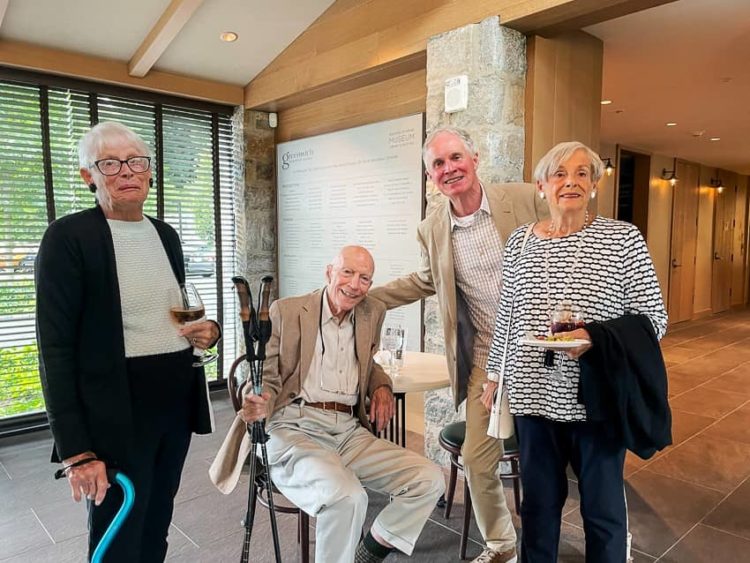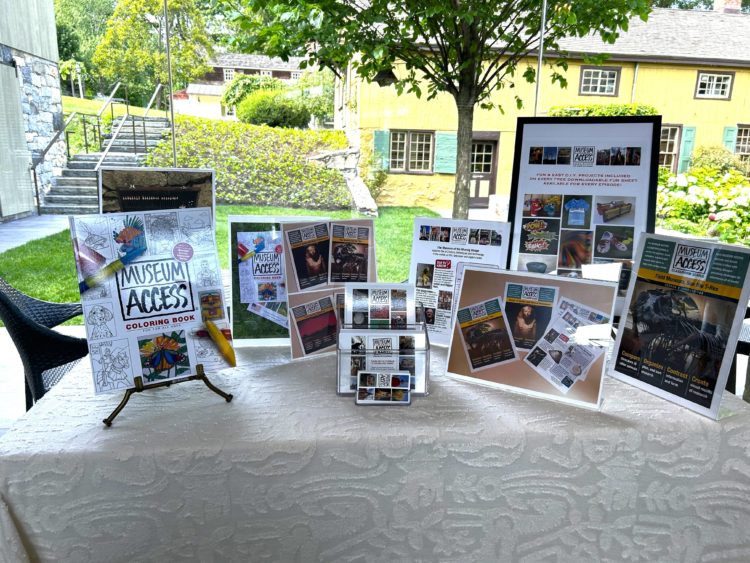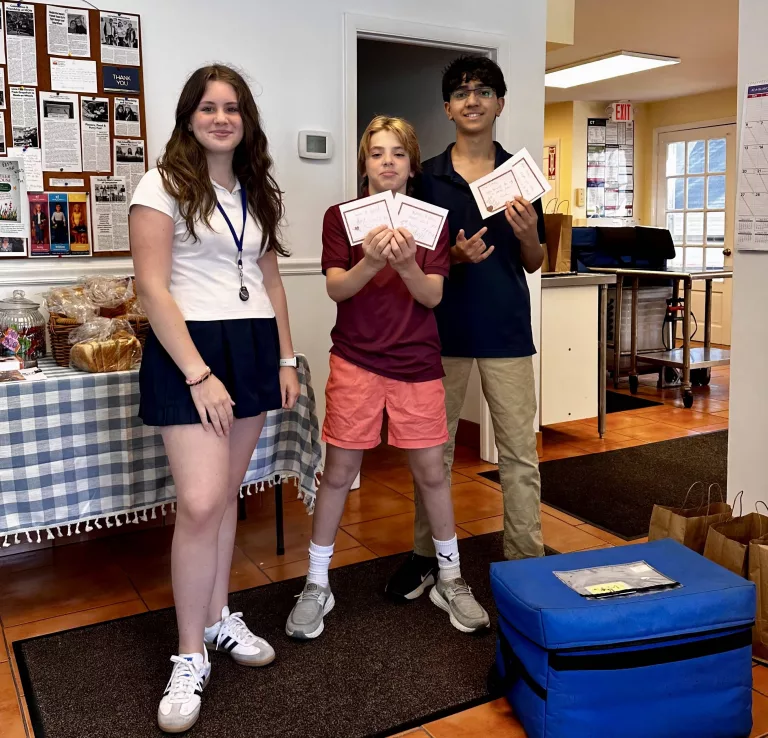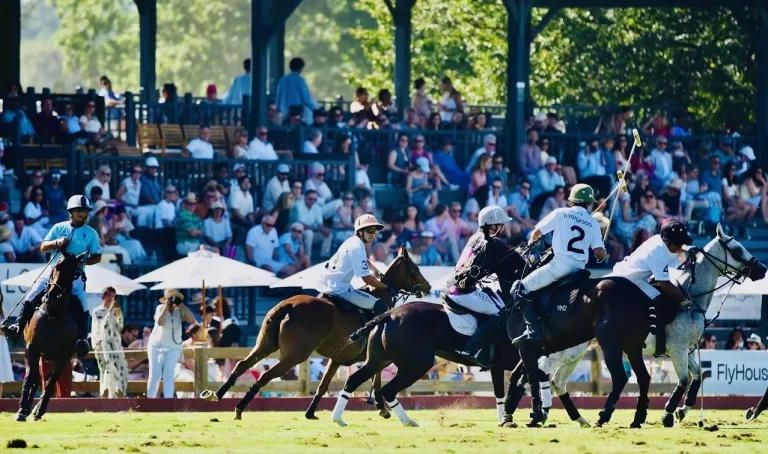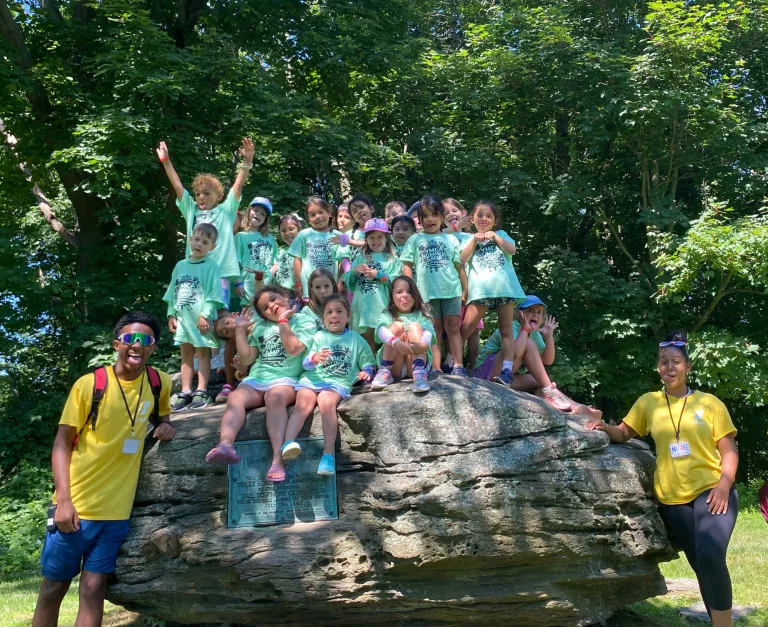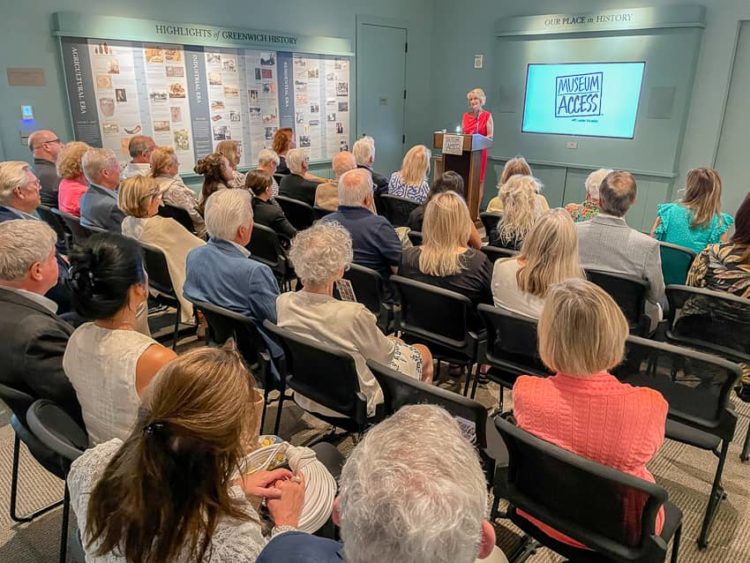
Anne W. Semmes
For five years Greenwich’s Leslie Mueller has been sharing her energetic, educated, and artistic self to introduce the wonders and richness found in the many museums she visits across our country in her Museum Access half-hour public television program. To celebrate her now 50 episodes and the launch of her fifth season Mueller hosted 50 of her friends and film crew at the Greenwich Historical Society (GHS) two Wednesdays ago.
Next week Mueller will film the first of 10 episodes of Season 6 at the Bruce Museum featuring its American Impressionist paintings with another filming at the Historical Society’s Bush-Holley House, the birthplace of the Cos Cob Art Colony.
“The American Impressionists really started here,” she told the gathered crowd in her talk in the GHS Museum Gallery. “If you look out the window, you can see the boarding house that they stayed in and the barn that they painted in and the scenes that they painted, Childe Hassam, Leonard Ochtman, Alden Weir…Everybody knows Monet and the French artists, but not so much these artists. They really put Cos Cob on the map, and by the way, this Colony started before the Bruce Museum.”
Mueller was quick to introduce a key player in her Museum Access venture, her videographer/director Tobias Baharian, present in the Gallery. “Not only does he have the professional and creative eye to be able to shoot a majority of our episodes, but to be on set when you’ve got people that are nervous about being on camera, he can make sure that they’re comfortable, which calms me down a little bit too.”
Mueller’s Museum Access, which has featured high profile museums like the Metropolitan Museum of Art to the less known National Museum of Mathematics, now has an outreach of nine million viewers aged 18 to 50, and 12 million including kids from k-12. Its readily accessible on Public Television and PBS stations, as well as on Amazon Prime.
Mueller told of Baharian being at the Cablevision studio in Connecticut when she was producing the award-winning show, Art & Style, when their conversation turned to having a show featuring museums. The two were soon headed for the Metropolitan Museum to begin creating their introductory reel. “I’m standing in front of the Met between the fountain and the stairs and I’m saying, ‘Hi, I’m Leslie Mueller, and I want to welcome you to Museum Access.’”
“We go back to the Met garage, change clothes, go to the Guggenheim, do the same thing,” she said to laughs. Then it was on to the American Museum of Natural History, and a bit further away the Intrepid Sea and Space Museum, and then the Cloisters on the way home. “So, we never went in any of them,” she noted, “we were actually outside.” (And somehow their shooting did not bring on the security!)
But to pitch their idea to PBS more museums were needed. “So, we headed to Chicago where I had grown up going to all the museums and started at the Museum of Science and Industry – it’s the crown jewel out there. We did the same thing – ‘here we are,’ then went to the Field Museum, to the Shedd Aquarium, the Adler Planetarium, and ended up at the Art Institute of Chicago where I had studied when I was 13.”
Sharing all with PBS “legend” Alan Foster he’d responded, “This is a great idea and public television is the perfect viewership for you.” “We like to say,” noted Mueller, “that at Museum Access we live at the intersection of entertainment, education and inspiration. We really believe that there’s a power in museums to ignite your imagination and to inspire learning regardless of your age, your income, your ethnicity, or your geographic location.”
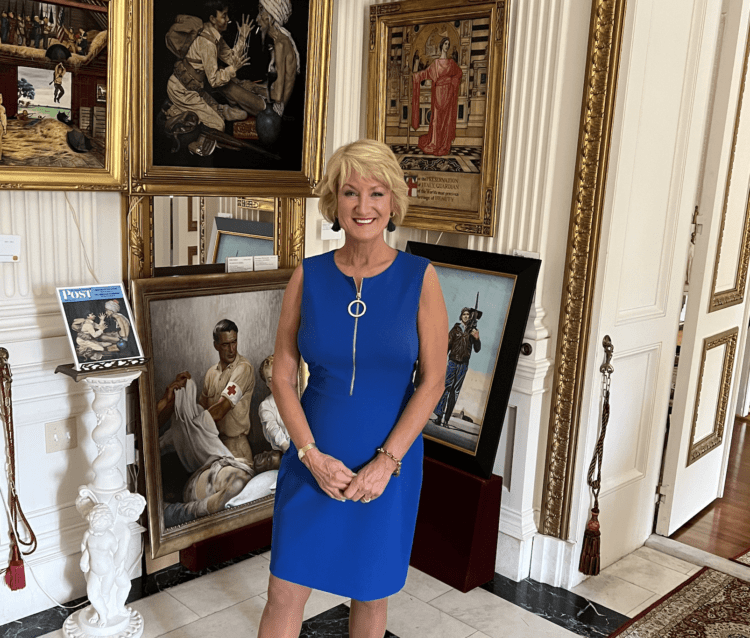
“We’re bringing that experience to those who probably wouldn’t have the opportunity to ever walk into the Metropolitan or the Art Institute or anywhere else,” she continued.” We have viewers that are in Alaska and South Dakota and Texas, and Canada, England, New Zealand and Australia.” She added, “We’ve captured 60 percent of the top 25 markets which doesn’t happen that often in public television.”
Mueller shared some clips of her episodes from Season 4. “Join us as we explore,” she begins, “We’re in Connecticut at the Mark Twain House & Museum.” She points to the small desk where Twain wrote. She’s overlooking the Hudson River at the West Point Military Museum. She’s touring the Ringling Museum – “Ringling is synonymous with the golden days of the circus world.” And at the American Museum of Natural History, she’s taking in the “breathtaking new gem hall.”
Mueller is proud of her new Season 5. “Despite the lingering challenges that Covid presented, we were still able to shoot at a wide variety of museums. In some ways it was better because they weren’t crowded. And lots of times we could go when they were closed – they were very anxious to share their collections.”
She gave us peaks at episodes of Season 5 that will air in late July including revisiting her personal favorites like the Wings of Freedom Aviation Museum (Her father was a bomber pilot in WWII.). Another favorite are those cultural destinations found in our museums, such as the Met’s Temple of Dendur from Egypt and the Terracotta Warriors from China in the Field Museum. And, amazingly, she allows you to see trailers of every episode on her website www.museumaccess.com.
So, how is Mueller’s venture funded? “Public television doesn’t pay producers for their content. So, we partner with NETA, the National Educational Telecommunications Association.” “That partnership allows,” she said, “tax deductible donations on our behalf. And that helps pay for production and postproduction.” (Donations can be made to her website.)
Especially impressive was learning of Mueller’s additional efforts as educator. She had thought, why not produce “collateral material that people could download for free from our website (www.museumaccess.com).” Like an educative coloring book, and “fun facts” for each of the 50 episodes…and lesson plans for teachers and homeschoolers of selected episodes. “So, a teacher could show something on the Shedd Aquarium episode and have almost six months of lesson plans at all different levels for kids to learn more about it.”
And from all that remote learning coming out of Covid Mueller was being approached by online educational platforms. “So, we decided to include an even broader range of museums to cover STEAM (science, technology, engineering, arts and math) related topics that could interest both adults and children. So that really worked out well.” One platform, Discovery Education, serves classrooms around the world. “And they were interested in offering virtual field trips. So, our series was actually a perfect fit. They reach 4.5 million educators, 45 million students, and over 100 countries.”
Mueller is also especially proud of working with the DCMP (Described and Captioned Media Program) funded by the U.S. Department of Education. “They support children who are deaf or blind with content for K through 12 students. So, we provide closed captioning and video descriptions on every one of our 50 episodes, and they’re always thrilled to get it.”
In the final analysis Mueller sees Museum Access as “really more about storytelling. The series gives us the opportunity to share the stories that are shared with us when we go to these fantastic locations.” And for Mueller, curiosity is her “driving force.”
“Storytelling and curiosity really enhance each other and give power to one another.” She cites “curiosity and determination” for keeping Museum Access “on track with the encouragement, the financial support, and the moral support that people like you have given us through the years.”
“We hope to continue bringing these museums to you because we really do feel that museums have the power to change lives, whether you’re nine years old or 90 years old. So, thank you for joining us on the journey and for celebrating 50 episodes.”

